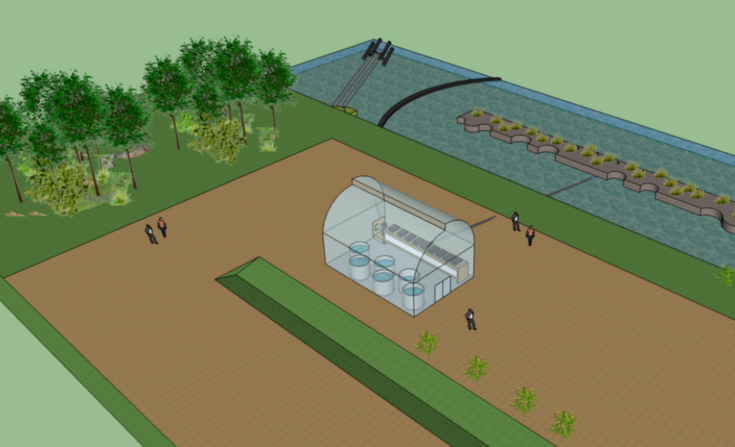
 |
| Reviews and Templates for Expression We |
Tapping into Nature: Systems thinking feeds inspiration

This is an excerpt from the Tapping into Nature report by Terrapin Bright Green.
An ecosystem is a complex, intricate system that processes materials, energy and information, often cycling these constituents within and between subsystems. Through evolution, nature creates flourishing ecosystems that optimize material and energy use.
A valuable characteristic of ecosystems is that they operate from nano- to macroscales, allowing materials and energy to be reused and transferred across scales. Intentionally mimicking these key characteristics and harmoniously connecting society’s industrial processes, building operations and urban infrastructure to natural systems offers a path to a prosperous and resilient future for our society.
Selected strategies
Cyclic flows
The concept of waste does not exist in nature. In an ecosystem, resources discarded by one organism or community are harnessed by another, establishing symbiotic, cyclic flows. This occurs from the cellular scale (such as bacteria) to the macroscale (such as forests) and can create countless niches for growth. In comparison, human systems typically generate large amounts of waste.
However, industrial by-products can be minimized by forming an industrial symbiosis — exchanging waste materials and energy as valued commodities between industries. Similar to biological symbiosis, individual companies benefit from shared services and the exchange of resources in the resulting system, increasing profits and dramatically reducing environmental impacts.
Interdependence
Ecosystems provide a wealth of inspiration for systems thinking. They also influence and integrate with our human-constructed systems. Viewing humans and nature as interconnected parts of a larger system allows us to evaluate how industrial processes, agriculture, buildings and cities function in relation to our relatively frugal and efficient counterparts in nature. To evaluate the efficacy of projects in the built environment, Terrapin is developing the Phoebe Framework.
Emergence
In a phenomenon known as emergence, complex systems have patterns and qualities that arise from the interactions among smaller components. Ecosystems exhibit many emergent properties, such as self-organization and adaptation, which can be incorporated into our engineered systems to address changing cultural, technical and societal issues.
Ecosystem services are another example of emergence, providing us with "services" such as food, water, fuel, disease control and recreation. To continue to benefit from these services, human systems can look to restoration ecology, the Phoebe Framework and other efforts to support the systems that produce them.
Existing products
Kalundborg Symbiosis
The industrial park of Kalundborg, Denmark, boasts a successful industrial symbiosis. Adjacent industrial facilities exchange resources and energy by-products so that one plant’s waste becomes a feedstock for others. The sophisticated system currently includes a power plant, oil refinery, gypsum board manufacturer, biofuel producer, pharmaceutical manufacturer, fish and pig farms, fertilizer companies, cement companies and the largest wastewater treatment plant in northern Europe, among other businesses.
Some of the resources exchanged include fly ash, water, gas, fertilizer, and heat. Each year, Kalundborg’s system avoids the emission of 240,000 tons of CO2 and the use of 800 million gallons of water, saving an estimated $15 million. The Kalundborg Symbiosis organization aims to attract more industrial partners who are seeking to reduce their environmental impact and increase their profit margins.
Eco-Machines
John Todd Ecological Design creates cost-effective wastewater treatment systems that harness the digestion and filtration functions of wetland ecosystems without using hazardous chemicals. Eco-Machine systems consist of a series of tanks and water gardens housed in greenhouses or in constructed wetlands. Wastewater is filtered and polished by aquatic beds or constructed wetlands. The system contains all the major agents (bacteria, algae, snails, fungi, plants, fish, clams) of a wetland ecosystem. The Eco-Machines vary based on a project’s climate, land area and daily volume of wastewater.
An Eco-Machine installed at the Ethel M. Chocolates facility in Nevada treats all of its industrial wastewater (around 32,000 gallons daily) and uses the filtered water to irrigate landscaping, eliminating the facility’s municipal discharge fees while conserving water. The system is less expensive to build and operate than conventional treatment systems.
Products in development
Phoebe Framework
The Framework for an Ecological Built Environment ("Phoebe Framework" or "Phoebe") is a suite of tools in development at Terrapin that uses ecosystem-based assessment to guide sustainable and resilient development of buildings and communities. Phoebe merges sustainable design with environmental planning, industrial ecology and restoration ecology, evaluating a site within its larger ecological context.
Phoebe has three primary goals: Connect humans to natural systems; establish ecological functions and processes on-site, aligning the built environment to regional ecosystems; and integrate larger ecosystem impacts into planning and decision making. Phoebe’s advantage is that it does not adhere to universal metrics but crafts solutions tailored to a site’s challenges.
Using Phoebe restores local ecosystems, reduces a site’s environmental impact and provides building owners and operators with opportunities to save money through risk mitigation, reduced resource consumption and improved health and productivity.
|
|
|
|
Copyright 2011 Energy and Technical Services Ltd. All Rights Reserved. Energyts.com |